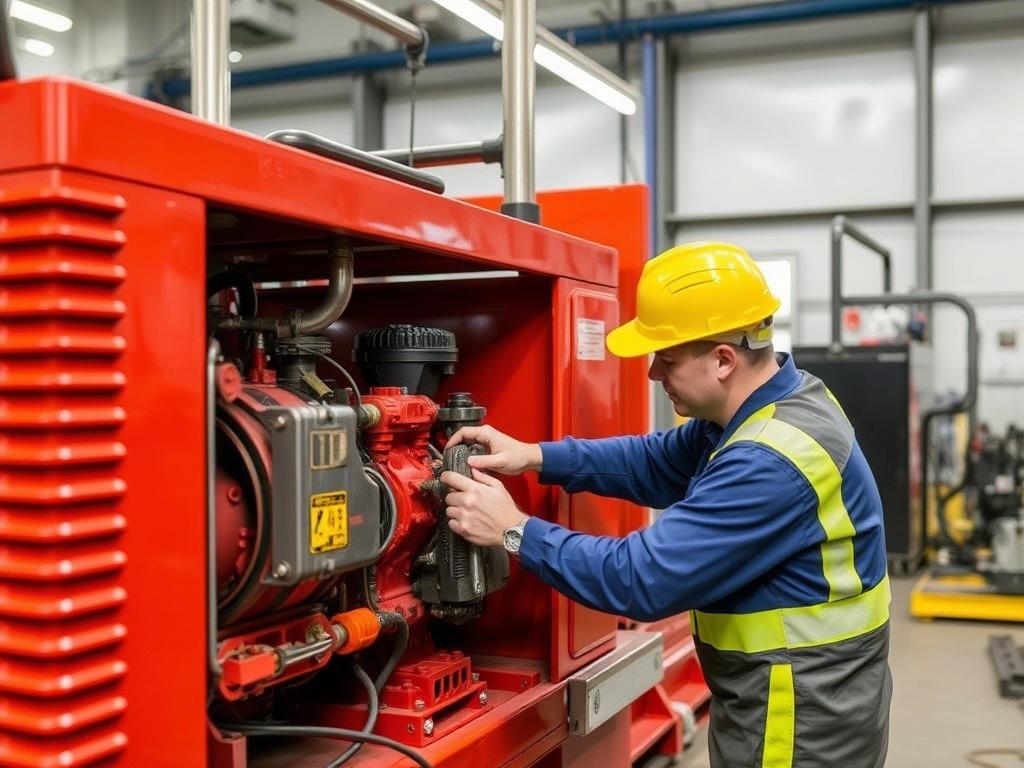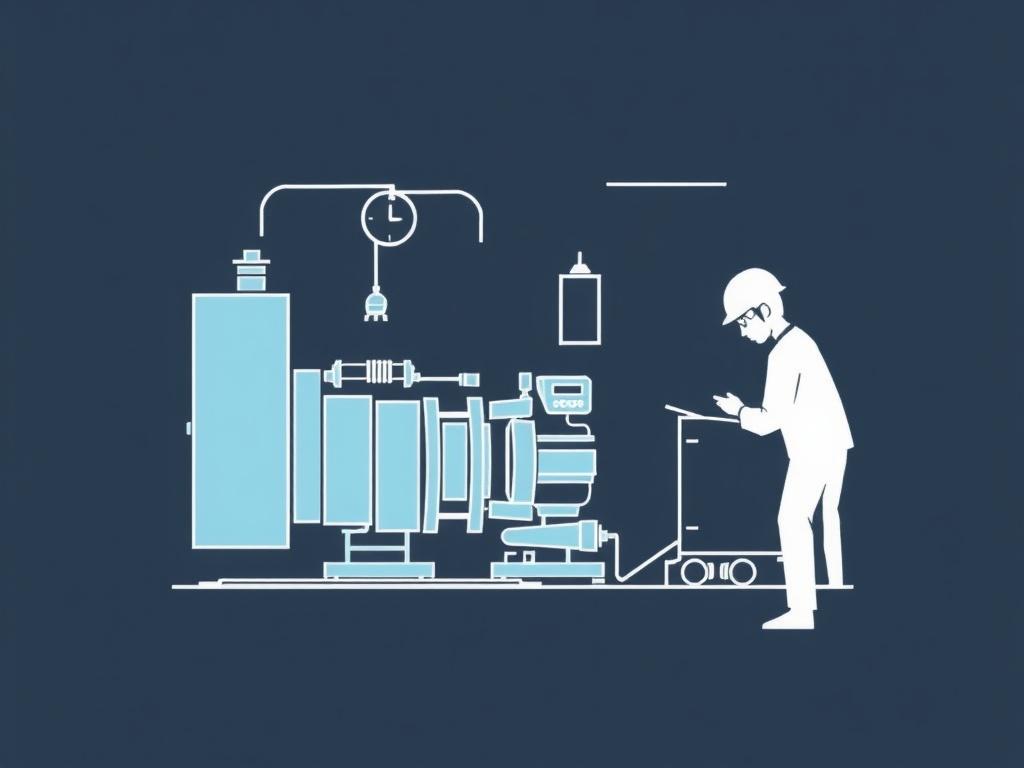Международное название:
Синонимы:
Характеристики:
| Сложность: | |
| Цикл развития: | |
| Световой режим: | |
| Режим полива: | |
| Температура: | |
| Почва: | |
| Ключевая черта: |
Цвет листвы
Цвет бутонов
Размеры цветка
Систематика:
| Домен: | |
| Царство: | |
| Отдел: | |
| Класс: | |
| Порядок: | |
| Семейство: | |
| Род: |
Keeping equipment running smoothly is as much an art as it is a science. Walk into any busy plant, hospital, or data center and you’ll find a delicate choreography of machines, people, and processes. When one step in that dance falters, downtime can ripple through operations, stealing productivity and profits. This article walks through the full life cycle of building equipment maintenance schedules designed to avoid downtime — from understanding the different maintenance philosophies to creating practical schedules, using data and technology wisely, and keeping teams engaged. Read on like you’re having a coffee with a colleague who’s been through the trials, errors, and triumphs of maintenance planning.
You’ll find clear steps, real-world examples, practical tables you can adapt, templates for weekly-to-annual tasks, and checklists that help teams implement changes immediately. Whether you manage a small workshop, a manufacturing line, or a large facility, the methods below scale to your needs. I’ll keep the language simple and conversational, and I’ll show you how to think about maintenance not as a cost center but as a reliability engine that protects uptime and improves your bottom line.
- Why a Good Maintenance Schedule Matters
- Core benefits of well-designed maintenance schedules
- Understand Maintenance Types: Pick the Right Mix
- Preventive Maintenance (PM)
- Predictive Maintenance (PdM)
- Reactive (Run-to-Failure) Maintenance
- Step-by-Step: Building a Maintenance Schedule That Prevents Downtime
- Step 1 — Inventory and Asset Register
- Step 2 — Criticality and Risk Assessment
- Step 3 — Gather Maintenance History and OEM Recommendations
- Step 4 — Define Maintenance Tasks and Frequencies
- Step 5 — Create Playbooks and Checklists
- Step 6 — Assign Roles and Build the Calendar
- Step 7 — Implement Data Collection and KPIs
- Step 8 — Pilot, Adjust, and Scale
- Templates You Can Use Right Away
- Example Weekly Checklist (HTML List)
- Using Technology: CMMS, IoT, and Predictive Tools
- Choosing a CMMS
- Incorporating Predictive Maintenance
- Prioritization: Focus on the Right Things
- Parts, Procurement, and Inventory Management
- Classify spare parts
- Procurement tips
- Workforce Strategy: Training and Ownership
- Operator-driven maintenance
- Cross-training and competence
- Shift handover and communication
- Metrics That Matter
- Common Pitfalls and How to Avoid Them
- Pitfall — Over-scheduling
- Pitfall — Ignoring Operator Observations
- Pitfall — Treating the CMMS as a Filing Cabinet
- Pitfall — No Continuous Improvement Loop
- Case Study Examples (Short Sketches)
- Small Food Processing Plant
- Medium-sized Manufacturing Facility
- Hospital Facilities
- Emergency Response and Shutdown Planning
- Emergency response checklist
- Planned shutdown (turnaround) best practices
- Continuous Improvement: Use Data to Evolve Your Schedule
- Feedback loop
- Budgeting and Business Case: Show the ROI
- Checklist: Launching a Maintenance Schedule in 90 Days
- Final Tips from People Who’ve Been There
- Conclusion
Why a Good Maintenance Schedule Matters
A maintenance schedule is more than a calendar of to-dos. It’s the backbone of a proactive reliability strategy. When machines are serviced regularly and intelligently, failures drop, safety improves, and your team works with confidence instead of firefighting.
Think of it like this: imagine your car never had scheduled oil changes. Eventually it would fail — often at the worst possible time. The same principle applies to machinery: routine care prevents small issues from becoming catastrophic. A structured maintenance schedule reduces emergency repairs, extends the life of assets, and helps you plan labor and spare parts. It also creates measurable data, so you can make smarter decisions about replacement versus repair.
Core benefits of well-designed maintenance schedules
- Lower unplanned downtime and production losses
- Reduced emergency repair costs and overtime labor
- Longer equipment lifecycles and optimized asset replacement
- Improved safety and regulatory compliance
- Better inventory control for spare parts
- Predictable budgeting and improved ROI on maintenance tools
Understand Maintenance Types: Pick the Right Mix
Before you build a schedule, you need to choose the right mix of maintenance strategies. No single approach fits every piece of equipment. The most effective programs blend preventive, predictive, and reactive maintenance in a way that prioritizes critical assets and minimizes risk.
Preventive Maintenance (PM)
Preventive maintenance is time- or usage-based care — oil changes, filter replacements, lubrication, inspections. PM is predictable and easy to schedule, and it’s the backbone of most maintenance programs. However, doing PM too often wastes resources; doing it too infrequently risks failure.
Predictive Maintenance (PdM)
Predictive maintenance uses condition-monitoring technologies — vibration analysis, thermography, oil analysis, acoustic sensors, IoT data — to predict failures before they happen. PdM increases accuracy and reduces unnecessary interventions, but it requires investment in sensors, software, and skilled analysis.
Reactive (Run-to-Failure) Maintenance
Some non-critical equipment can be allowed to run until failure. This is acceptable for low-cost, non-essential items, but should never be the approach for mission-critical assets. Run-to-failure is a deliberate choice to avoid overspending on unnecessary PM.
Step-by-Step: Building a Maintenance Schedule That Prevents Downtime

Here’s a practical roadmap you can follow. It works for a small facility and scales up to enterprise operations.
Step 1 — Inventory and Asset Register
Start with a complete list of your equipment. No guessing. Document model, serial number, manufacturer, installation date, location, and a simple criticality tag (A, B, C). Use a spreadsheet or, better, a CMMS (Computerized Maintenance Management System).
Step 2 — Criticality and Risk Assessment
Not all equipment is equal. Map out which assets are critical to operations, safety, compliance, or revenue. Rank assets using simple criteria such as:
- Impact on production if it fails
- Safety or environmental risk
- Cost/time to repair or replace
- Availability of spare parts
Assign a priority level (e.g., Critical, High, Medium, Low). Focus your resources on the top tiers.
Step 3 — Gather Maintenance History and OEM Recommendations
Look up manufacturer recommendations and historical failure data. Review past work orders to identify recurring problems. Often, the best schedule is a blend of OEM guidance and what the data shows about your actual operating environment.
Step 4 — Define Maintenance Tasks and Frequencies
For each asset, list tasks required (inspection, cleaning, lubrication, part replacement) and propose a frequency: daily, weekly, monthly, quarterly, semi-annual, annual, or condition-based. Keep tasks specific and measurable — e.g., “Lubricate bearings with grease type X, quantity Y, record pressure reading.”
Step 5 — Create Playbooks and Checklists
Turn each task into a clear checklist that any trained technician can follow. Include safety steps, required tools, spare parts, and acceptance criteria (what indicates the asset is fit for service).
Step 6 — Assign Roles and Build the Calendar
Assign tasks to roles (technician, operator, supervisor), not just names. Put tasks on a calendar considering production schedules to minimize downtime. For critical assets, schedule inspections during shifts that have fastest response capability.
Step 7 — Implement Data Collection and KPIs
Decide what data you’ll collect: work order completion times, mean time between failures (MTBF), mean time to repair (MTTR), percentage of planned vs unplanned maintenance. These KPIs help you assess effectiveness.
Step 8 — Pilot, Adjust, and Scale
Start with a pilot on a handful of critical assets. Track results for three to six months, adjust frequencies and tasks based on outcomes, then roll out across the plant.
Templates You Can Use Right Away
Below is a sample maintenance schedule table you can adapt. Use it as a starting point and tailor the frequencies to your environment.
| Equipment | Task | Frequency | Estimated Time | Assigned To | Spare Parts Needed | Notes |
|---|---|---|---|---|---|---|
| Conveyor Motor #1 | Inspect belt tension, lubricate bearings, check alignment | Weekly | 45 min | Maintenance Tech | Bearing grease, spare belt | Record vibration readings |
| HVAC Unit A | Replace filters, inspect coils, check refrigerant pressures | Monthly | 1.5 hrs | HVAC Technician | Filters, refrigerant monitor | Log airflow readings |
| Backup Generator | Run load test, check fuel, battery test | Quarterly | 2 hrs | Electrical Team | Battery pack, filters | Test under 50% and 100% load |
| Packaging Robot | Firmware check, sensor calibration, clean optics | Semi-Annual | 3 hrs | Robotics Tech | Calibration kit | Backup configs before updates |
Example Weekly Checklist (HTML List)
- Walk-around inspection of production area for leaks or unusual sounds
- Check lubrication points on all bearings
- Inspect belts and chains for wear and proper tension
- Verify safety interlocks and emergency stops
- Clean filters on air intakes and fans
- Review pending work orders and prioritize
Using Technology: CMMS, IoT, and Predictive Tools
Technology has transformed how schedules are managed. A CMMS centralizes asset data, automates work orders, tracks spare parts, and generates reports. IoT sensors and predictive analytics add another layer of insight, turning maintenance from calendar-based to condition-based.
Choosing a CMMS
When evaluating a CMMS, look for the following features:
- Asset registry with document storage (manuals, schematics)
- Work order creation and tracking
- Scheduling and recurring tasks
- Inventory and spare parts management
- Reporting and KPI dashboards
- Mobile access for technicians
A good CMMS will automate routine PMs, send reminders, and track labor hours, making it much easier to measure planned vs. unplanned work.
Incorporating Predictive Maintenance
Start small with PdM: pick a handful of critical assets and add vibration, temperature, or oil sensors. Build baseline readings and set thresholds. Over time, you can use machine learning to predict failure probabilities and trigger maintenance only when needed, saving time and parts.
Prioritization: Focus on the Right Things
A common mistake is spreading maintenance too thin. Use a prioritization matrix that considers likelihood and consequence of failure. Critical assets should have tighter monitoring and redundancy if possible.
| Priority | Typical Frequency | Focus |
|---|---|---|
| Critical (A) | Daily to weekly inspections; continuous monitoring | Redundancy, predictive sensors, quick-response spares |
| High (B) | Weekly to monthly | Preventive checks and condition monitoring |
| Medium (C) | Monthly to quarterly | Standard preventive tasks |
| Low (D) | Semi-annual to run-to-failure | Minimal preventive work, allow run-to-failure if acceptable |
Parts, Procurement, and Inventory Management
Even the best schedule fails if you don’t have the right parts on hand. A well-run spare parts program balances availability with inventory cost.
Classify spare parts
- Critical spares — must be kept in stock (motors, PLCs, bearings for critical machines)
- Common spares — parts used frequently across multiple assets (belts, filters)
- Slow-moving spares — low-use parts kept based on lead time and risk
Use ABC analysis and minimum/maximum stock levels. Tie inventory management to your CMMS so work orders automatically reserve parts.
Procurement tips
- Keep lead times and vendor reliability in your asset register.
- Hold safety stock for critical, long-lead items.
- Negotiate service agreements for rapid support on key assets.
- Consider consignment stock for expensive, rarely used parts with critical impact.
Workforce Strategy: Training and Ownership
A schedule is only useful if people follow it. Make sure technicians and operators understand their roles and have clear guidance.
Operator-driven maintenance
Operators are your first line of defense. Train them to perform basic checks and log anomalies. Operator ownership reduces the burden on maintenance and speeds detection of issues.
Cross-training and competence
Ensure multiple staff can cover critical tasks. Use competency matrices to track who is qualified for what, and provide regular training and refreshers.
Shift handover and communication
Document handover procedures and use concise shift logs. The more standardized your communication, the fewer things slip through the cracks.
Metrics That Matter
Track KPIs that tie directly to downtime and reliability improvements. Here are the core metrics to monitor:
| KPI | What it Measures | Target/Goal |
|---|---|---|
| Planned Maintenance Percentage (PMP) | Percent of maintenance hours that are planned | Goal: >70% planned |
| Mean Time Between Failures (MTBF) | Average time equipment operates between failures | Higher is better |
| Mean Time To Repair (MTTR) | Average time to restore equipment to operation | Lower is better |
| Overall Equipment Effectiveness (OEE) | Availability × Performance × Quality | Industry dependent; track trend improvements |
| Work Order Compliance | Percentage of PMs completed on time | Target: >90% |
Common Pitfalls and How to Avoid Them
Even good programs stumble. Here are pitfalls I’ve seen and how to sidestep them.
Pitfall — Over-scheduling
If your PM program has too many tasks, technicians burn out and compliance drops. Start with essentials, then refine using failure data.
Pitfall — Ignoring Operator Observations
Operators often notice subtle changes first. Build a culture where their input is valued and acted upon.
Pitfall — Treating the CMMS as a Filing Cabinet
A CMMS is only useful if data is entered consistently and used for decision-making. Train staff to use it and enforce data hygiene.
Pitfall — No Continuous Improvement Loop
A schedule is not static. Review KPIs monthly, adjust frequencies, and update checklists based on what the data tells you.
Case Study Examples (Short Sketches)

Small Food Processing Plant
A plant struggled with repeated packaging line stoppages. They performed a rapid criticality assessment and installed a simple vibration sensor on the top three motors. They adjusted their PM schedule to include weekly belt checks and monthly vibration reviews. Within six months, unplanned downtime decreased by 60%, and emergency repair costs dropped significantly.
Medium-sized Manufacturing Facility
A factory implemented a CMMS and started logging every work order. After a year, they used the data to reclassify assets and reduced PM frequency on low-risk items, saving labor hours. They invested in thermography for critical electrical panels, catching loose connections before they caused outages.
Hospital Facilities
Hospitals combine strict regulatory compliance with the need for absolute reliability. One hospital created a layered plan: daily rounds by biomedical techs, weekly HVAC checks, and continuous monitoring for backup generators. They prioritized critical spares and developed a fast-response vendor list — a move that proved invaluable during a storm-related power event.
Emergency Response and Shutdown Planning
Unexpected failures still happen. Have a clear emergency response plan and a scheduled shutdown playbook for major preventive overhauls.
Emergency response checklist
- Immediate stop and safety procedures
- Containment for spills or hazards
- Initial diagnostic steps and who to call
- Communication plan to operations and management
- Follow-up root cause analysis after restoration
Planned shutdown (turnaround) best practices
- Start planning 6–12 months in advance for major shutdowns
- Create a detailed scope and schedule with resource assignments
- Stockpile required spares and pre-order long-lead items
- Use contractors for specialized tasks and coordinate permits/safety
- Review lessons learned to improve the next turnaround
Continuous Improvement: Use Data to Evolve Your Schedule
A schedule that’s right today might be wrong next year. Set a cadence for review — monthly for KPIs and quarterly for frequencies and tasks. Use Pareto analysis to focus on the few assets that cause the most problems.
Feedback loop
- Collect data from CMMS and sensors
- Analyze failures and near-misses
- Adjust PM frequencies and add PdM where it pays off
- Train staff on changes and update checklists
- Repeat
Budgeting and Business Case: Show the ROI
Building and defending a maintenance budget requires translating reliability efforts into dollars saved. Estimate the cost of downtime by calculating lost output, labor, and potential penalties. Compare that to the cost of a PM program including labor, tools, sensors, and spares.
Use a simple table in proposals:
| Item | Current Annual Cost | Projected Cost After PM | Net Savings |
|---|---|---|---|
| Unplanned Downtime | $250,000 | $100,000 | $150,000 |
| Emergency Repairs | $80,000 | $30,000 | $50,000 |
| PM Program Cost | $0 | $50,000 | -$50,000 |
| Total | $330,000 | $180,000 | $150,000 |
This kind of transparent calculation helps leadership see the bottom-line benefits of investing in reliability.
Checklist: Launching a Maintenance Schedule in 90 Days
Follow this practical 90-day plan to get a program off the ground quickly.
- Day 1–7: Complete asset register and criticality ranking.
- Day 8–21: Gather OEM manuals, historical data, and interview operators.
- Day 22–35: Create initial PM tasks and simple checklists for top 20% critical assets.
- Day 36–50: Implement a CMMS or a structured spreadsheet schedule and assign roles.
- Day 51–70: Pilot PdM on 2–3 assets with sensors or vibration checks.
- Day 71–90: Review KPIs, adjust frequencies, and roll out to remaining critical equipment.
Final Tips from People Who’ve Been There
- Start small and win early. Small wins build credibility faster than a perfect plan that takes years to implement.
- Involve operators early. Their buy-in makes schedules practical and enforceable.
- Don’t be afraid to change frequencies. Use data to justify changes, not guesswork.
- Invest in training and tools — skilled people and good diagnostic tools are the best insurance against downtime.
- Make the CMMS the system of record — inconsistent data is worse than no data.
Conclusion
Creating equipment maintenance schedules to avoid downtime is a strategic mix of inventorying assets, assessing criticality, blending preventive and predictive approaches, using the right technology, and continually improving based on data and feedback; start with essentials, focus on critical assets, use simple templates and checklists, equip and train your team, measure the right KPIs, and iterate — do that and you’ll turn maintenance from a cost center into a reliability engine that saves money, boosts safety, and keeps operations humming.
Оценивайте статью, делитесь материалом с друзьями в социальных сетях, а также высказывайте свое мнение в обсуждении ниже! ![]()







